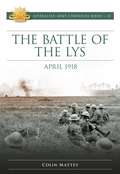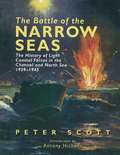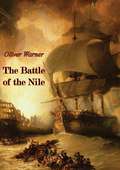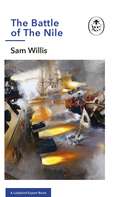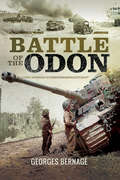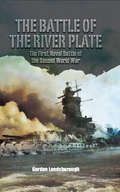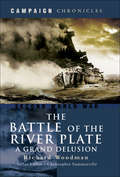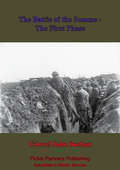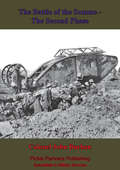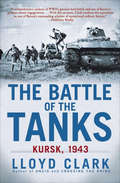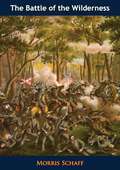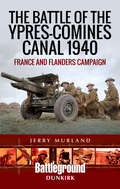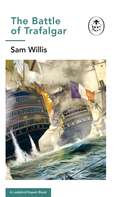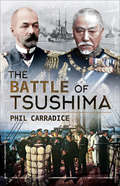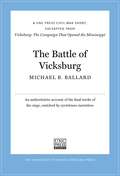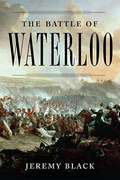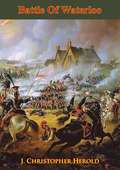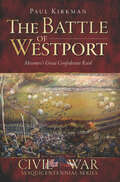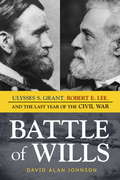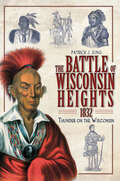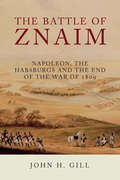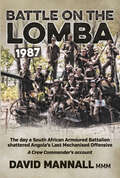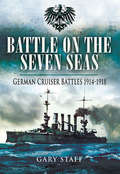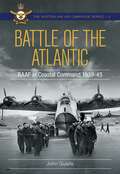- Table View
- List View
The Battle of the Lys April 1918 (Australian Army Campaigns #25)
by Colin MatteyIn the wave of devastating German offensives launched in the spring of 1918, it is Operation Michael that has captured most attention, characterised by astonishing advances and their potentially shattering impact on the British Expeditionary Force’s (BEF) Third and Fifth armies. While this offensive eventually petered out, albeit tantalisingly close to the BEF’s crucial logistic hub of Amiens, German General Ludendorff redirected the German effort north to Flanders to launch Operation Georgette. In Flanders, the BEF front line lay alarmingly close to the vital channel ports, and the main German thrust posed a direct threat to the town of Hazebrouck, the BEF’s second key logistic hub. After four years of grinding and horrific war, all that stood between the Germans and victory was the 1st Australian Division, hastily recalled to defend the town. This volume describes the battle to save Hazebrouck — part of what was to become the Battle of the Lys — and focuses on the role of the 1st Australian Division in halting the surging German thrust towards the town. While often neglected by history, this action was critical to the survival of the BEF and the Allied war effort in 1918 and deserves far greater recognition. The Battle of the Lys also brings the performance of the BEF divisions during Operation Georgette into sharper focus while providing a unique opportunity to reassess BEF and German performances at what was a decisive point in the First World War.
The Battle of the Narrow Seas: The History of Light Coastal Forces in the Channel and North Sea, 1939–1945
by Peter ScottThis is the story of the struggle for the control of the narrow seas of the Channel and the southern North Sea during the Second World War, told by Peter Scott who, as a MTB commander, saw action against the enemy throughout the course of the War.The book is much more than a memoir and tells the whole story of the wide-ranging conflict against the Germans, fought in the congested waters of the Channel. Actions against convoys and E-boats, often under the shadows of French cliffs, an impossible sortie against Scharnhorst and Gneisenau as they ran the gauntlet through the Straits in February 1942, the attack on St Nazaire, and the defensive and offensive roles taken on by MTBs during the D-Day landings are just some of the events covered in the book.The bravery of the crews of these small ships became legendary and the casualties that were suffered during brief and fierce encounters were horrific. As the War dragged on Motor Torpedo Boats became household words, and their activities, often described, perhaps a little luridly in the press, helped to raise the morale of the nation in much the same way that the fighter aircraft had done in the Battle of Britain in September 1940. A much-needed new edition.
The Battle of the Nile
by Oliver WarnerFirst published in 1960, this is a gripping account of the decisive sea battle between the forces of Napoleon and the British under Nelson in 1798.The Battle of the Nile (also known as the Battle of Aboukir Bay) was a major naval battle fought between the British Royal Navy and the Navy of the French Republic at Aboukir Bay on the Mediterranean coast off the Nile Delta of Egypt from 1-3 August 1798. The battle was the climax of a naval campaign that had ranged across the Mediterranean during the previous three months, as a large French convoy sailed from Toulon to Alexandria carrying an expeditionary force under General Napoleon Bonaparte. The British fleet was led in the battle by Rear-Admiral Sir Horatio Nelson.
The Battle of The Nile: A Ladybird Expert Book (The Ladybird Expert Series #35)
by Sam WillisPart of the ALL-NEW LADYBIRD EXPERT SERIES- Why was the Battle of the Nile so decisive in the French Revolutionary Wars?- Why did the French believe they were unassailable?- And why did Nelson and the British win?TRACK the revolutionary roots and dramatic turning points of the British Royal Navy's glorious victory over the French naval expedition to Egypt. From Napoleon's rise to prominence to Nelson's celebrated tactical leadership, discover how this significant battle changed the face of the French Revolutionary Wars.THE BATTLE THAT CHANGED THE BALANCE OF POWER IN EUROPEWritten by historian, archaeologist, and broadcaster Sam Willis, Nelson: Battle of the Nile is a thrilling and accessible account of the naval battle that established Nelson's fame.
Battle of the Odon
by Georges BernageThe Battle of the Odon evokes the clash between the British Army and the II SS-Panzer Korps, as they attacked across the Odon Valley during Operation "Epsom" in June 1944.Using contemporary photographs and documents, this book provides day-by-day details of the operation that was just one part of what is commonly referred to as the 'Battle of Normandy'.
The Battle of the River Plate: The First Naval Battle of the Second World War
by Gordon LandsboroughAt dawn on 13 December 1939, smoke was seen on the horizon; HMS Exeter was told to close in and investigate. Two minutes later a dramatic signal was sent from the British cruiser I think it is a pocket battleship.It was. The Deutschland-class heavy cruiser Admiral Graf Spee, marauder of the South Atlantic shipping, had sailed into a trap. Three smaller British cruisers closed in on a German warship which, so Hitler had boasted, could out-sail any ship powerful enough to damage her, and out-gun any ship able to keep up with her an invincible ship.So began the Battle of the River Plate, story which has its duplicates in British naval history, but which nevertheless brought pride and inspiration into the hearts of a nation unwillingly at war once again.A terrible battle was fought that day off the coast of South America, a naval encounter in the finest Nelson tradition and true to that tradition, victory went to the men with the finest armament of all, courage.This edition will be presented with an Appendix containing the official despatch detailing the Battle of the River Plate.
The Battle of the River Plate: A Grand Delusion (Campaign Chronicles)
by Richard WoodmanA study and reassessment of the major World War II battle in the South Atlantic between the British and German navies. The Battle of the River Plate was the first major naval confrontation of the Second World War, and it is one of the most famous. The dramatic sea fight between the German pocket battleship Admiral Graf Spee and the British cruisers Exeter, Ajax, and Achilles off the coast of South America caught the imagination in December 1939. Over the last sixty years the episode has come to be seen as one of the classics of naval warfare. Yet the accepted interpretation of events has perhaps been taken for granted and is ripe for reassessment, and that is one of the aims of Richard Woodman&’s enthralling new study.Praise for The Battle of the River Plate: A Grand Delusion &“This author has made it all so very riveting, it really is a book which is hard to put down until finished.&” —Royal Geographical Society &“Graphic, thought provoking—highly recommended.&” —Britain at War
The Battle Of The Somme - The First Phase. [Illustrated Edition]
by Colonel John BuchanMore than any other battle of the First World War, the battle of the Somme remains as the abiding memory of the appalling conditions, suffering and death of British manhood in the public consciousness. As the guns stopped their bombardment on the 1st of July, the waves of Allied troops walked toward the often still intact German lines. More than a million men in total would be killed, wounded or captured on both sides before the fighting subsided in November.Colonel Buchan wrote his volume study of the battle from an enviable position as a high ranking intelligence officer, having access to much of the detail from the allied side of the offensive. One of the finest British authors of the age, he also wrote copious numbers of books on the First World War, of particular note the 24 volume 'Nelson's" history.Author -- Colonel Buchan, John, (Later Lord Tweedsmuir) 1875-1940.Text taken, whole and complete, from the edition published in London, T. Nelson and sons, ltd. 1916.Original Page Count - 108 pages.Illustrations -- numerous illustrations and plates
The Battle Of The Somme –The Second Phase. [Illustrated Edition]
by Colonel John BuchanMore than any other battle of the First World War, the battle of the Somme remains as the abiding memory of the appalling conditions, suffering and death of British manhood in the public consciousness. As the guns stopped their bombardment on the 1st of July, the waves of Allied troops walked toward the often still intact German lines. More than a million men in total would be killed, wounded or captured on both sides before the fighting subsided in November.Colonel Buchan wrote his volume study of the battle from an enviable position as a high ranking intelligence officer, having access to much of the detail from the allied side of the offensive. One of the finest British authors of the age, he also wrote copious numbers of books on the First World War, of particular note the 24 volume 'Nelson's" history.Author -- Colonel Buchan, John, (Later Lord Tweedsmuir) 1875-1940.Text taken, whole and complete, from the edition published in London, T. Nelson and sons, ltd. 1916.Original Page Count - 108 pages.Illustrations -- numerous illustrations and plates.
The Battle of the Tanks: Kursk, 1943
by Lloyd ClarkOn July 5, 1943, the greatest land battle in history began when Nazi and Red Army forces clashed near the town of Kursk, on the western border of the Soviet Union. Code named "Operation Citadel,” the German offensive would cut through the bulge in the eastern front that had been created following Germany’s retreat at the battle of Stalingrad. But the Soviets, well-informed about Germany’s plans through their network of spies, had months to prepare. Two million men supported by 6,000 tanks, 35,000 guns, and 5,000 aircraft convened in Kursk for an epic confrontation that was one of the most important military engagements in history, the epitome of "total war.” It was also one of the most bloody, and despite suffering seven times more casualties, the Soviets won a decisive victory that became a turning point in the war. With unprecedented access to the journals and testimonials of the officers, soldiers, political leaders, and citizens who lived through it, The Battle of the Tanks is the definitive account of an epic showdown that changed the course of history.
The Battle of the Wilderness
by Morris SchaffThe Battle of the Wilderness was fought on May 5–7, 1864 as the first battle of Lt.-Gen. U. S. Grant's Virginia Overland Campaign against Gen. Robert E. Lee and the Confederate Army of Northern Virginia. The fighting occurred in a wooded area near Locust Grove, Virginia, about 20 miles west of Fredericksburg. Although tactically inconclusive, both armies suffered heavy casualties, nearly 29,000 in total, a harbinger of a war of attrition by Grant against Lee's army and, eventually, the Confederate capital, Richmond, Virginia.>Grant attempted to move quickly through the dense underbrush of the Wilderness of Spotsylvania, but Lee launched two of his corps on parallel roads to intercept him. On the morning of May 5, the Union V Corps under Maj.-Gen. G. K. Warren attacked the Confederate Second Corps, commanded by Lt.-Gen. R. S. Ewell, on the Orange Turnpike. That afternoon the Third Corps, commanded by Lt.-Gen. A. P. Hill, encountered Brig.-Gen. G. W. Getty's division (VI Corps) and Major-Gen. W. S. Hancock's II Corps on the Orange Plank Road. Fighting, which ended for the evening because of darkness, was fierce but inconclusive as both sides attempted to maneuver in the dense woods.At dawn on May 6, Hancock attacked along the Plank Road, driving Hill's Corps back in confusion, but the First Corps of Lt.-Gen.l James Longstreet arrived in time to prevent the collapse of the Confederate right flank. Longstreet followed up with a surprise flanking attack that drove Hancock's men back, but the momentum was lost when Longstreet was wounded by his own men. An evening attack by Brig.-Gen. J. B. Gordon against the Union right flank caused consternation at the Union headquarters, but the lines stabilized and fighting ceased. On May 7, Grant disengaged and moved to the southeast, intending to leave the Wilderness to interpose his army between Lee and Richmond, leading to the Battle of Todd's Tavern and Battle of Spotsylvania Court House.
The Battle of the Ypres-Comines Canal 1940: France and Flanders Campaign (Battleground Dunkirk)
by Jerry MurlandThis WWII history and battlefield guide explores the significant yet lesser-known WWII combat along the Ypres-Comines Canal during the Battle of France.Known in some accounts as the Battle of Wijtschaete, the confrontation along the Ypres-Comines Canal in 1940 is too often overlooked despite its significance. The sacrifice of the battalions on the canal was vital to the all-important retreat to Dunkirk. The four-day conflict likely saved the British Expeditionary Force from almost complete destruction.Although there was fighting north of Ypres along the Canal Van Ieper Naar De Ijzer, the actual Battle of the Ypres-Comines Canal took place to the south. Three British brigades were pitted against three German divisions along the disused canal which runs from Comines in the south to Ypres in the north. Military historian Jerry Murland covers the order of battle of the British and German units engaged in the fighting.With more than 150 historic and modern photographs, ten maps, visits to eight CWGC Cemeteries, plus three car tours and two walking itineraries, this volume is an essential companion for exploring the area. Visitors will no doubt wish to combine a visit to the First World War sites around Ypres with the fighting along the canal in 1940, recognizing many places that were fought over in both wars.
The Battle of the Ypres-Comines Canal 1940: France and Flanders Campaign (Battleground Dunkirk)
by Jerry MurlandThis WWII history and battlefield guide explores the significant yet lesser-known WWII combat along the Ypres-Comines Canal during the Battle of France.Known in some accounts as the Battle of Wijtschaete, the confrontation along the Ypres-Comines Canal in 1940 is too often overlooked despite its significance. The sacrifice of the battalions on the canal was vital to the all-important retreat to Dunkirk. The four-day conflict likely saved the British Expeditionary Force from almost complete destruction.Although there was fighting north of Ypres along the Canal Van Ieper Naar De Ijzer, the actual Battle of the Ypres-Comines Canal took place to the south. Three British brigades were pitted against three German divisions along the disused canal which runs from Comines in the south to Ypres in the north. Military historian Jerry Murland covers the order of battle of the British and German units engaged in the fighting.With more than 150 historic and modern photographs, ten maps, visits to eight CWGC Cemeteries, plus three car tours and two walking itineraries, this volume is an essential companion for exploring the area. Visitors will no doubt wish to combine a visit to the First World War sites around Ypres with the fighting along the canal in 1940, recognizing many places that were fought over in both wars.
Battle of Trafalgar: A Ladybird Expert Book (The Ladybird Expert Series #28)
by Sam WillisPart of the ALL-NEW LADYBIRD EXPERT SERIES'Packs plenty of heft into its slender page count' HISTORY REVEALED- Why was the Battle of Trafalgar such an important British victory in the Napoleonic Wars? - How did the British fleet show their strength against the French and Spanish? - How did Nelson excel in his final battle?FOLLOW the daring strategy and brilliant leadership of Horatio Nelson in Britain's stunning triumph against Napoleon's forces. From the might of Britain's war machine to the death of the world's most impressive naval commander, discover why Trafalgar remains the most famous naval battle in history.BRITAIN'S GLORIOUS VICTORY, AND NELSON'S FINAL BATTLEWritten by historian, archaeologist, and broadcaster Sam Willis, The Battle of Trafalgar is a gripping and accessible introduction to the battle that established Britain as a formidable seapower for many years to come.
The Battle of Tsushima
by Phil CarradiceThe author of The First World War in the Air details the gripping 1905 naval battle during the Russo-Japanese War.In 1905 Japan and Russia were at war. With the Russian Far East Fleet destroyed, the Czar sent his Baltic Fleet halfway around the world to exact revenge. This mammoth journey took many months and was an amazing feat of seamanship. But, at the end of this adventure, the Russians were totally overwhelmed, and the majority of the fleet was underwater. There was no alternative for the Czar but to sue for an ignominious peace.The story of the journey and the final battle remain fascinating, the people involved behaving like characters from a novel. Russian Admiral Rozhestvensky was a gunnery expert but had never held active command in a major sea battle. Japanese Admiral Togo had trained in Britain, enlisting as a cadet on the Training Ship Worcester, even though he was far too old and was forced to lie about his age. Inept generalship on the part of the Russians, combined with brilliant seamanship from Togo, saw the complete destruction of the Russian fleet.The naval battle of Tsushima is one of the forgotten actions of the twentieth century, but it has a significance that is immense in world history.“An utterly compelling story, well told by Carradice. We really sympathize with the Russian sailors, trapped on their ironclad warships for months as they battled against the elements, a largely hostile world, and even each other. The result is an excellent book that reminds us of the human cost of these massive naval battles.” —History of War
The Battle of Vicksburg
by Michael B. BallardThe Vicksburg campaign was among the longest of the Civil War, lasting from 26 May 1862 to 4 July 1863. This Civil War Short provides a compelling narrative of the final six weeks of the campaign, excerpted from Michael Ballard's Vicksburg: The Campaign That Opened the Mississippi, which blends strategy and tactics with the human element, reminding us that while Gettysburg has become the focal point of the history and memory of the Civil War, the outcome at Vicksburg was met with as much celebration and relief in the North as the Gettysburg victory, and it should be viewed as equally important today.UNC Press Civil War Shorts excerpt rousing narratives from distinguished books published by the University of North Carolina Press on the military, political, social, and cultural history of the Civil War era. Produced exclusively in ebook format, they focus on pivotal moments and figures and are intended to provide a concise introduction, stir the imagination, and encourage further exploration of the topic. For in-depth analysis, contextualization, and perspective, we invite readers to consider the original publications from which these works are drawn.
The Battle of Waterloo
by Jeremy BlackThe name Waterloo has become synonymous with final, crushing defeat. Now thislegendary battle is re-created in a groundbreaking book by an eminent Britishmilitary historian making his major American debut.
Battle Of Waterloo [Illustrated Edition]
by J. Christopher Herold Jean HanoteauIllustrated with documents, paintings, and relics of the period. Renowned Napoleonic historian, J. Christopher Herold recounts the fascinating details of the great battle of Waterloo which ended the career of the greatest conqueror of modern times--Napoleon Bonaparte, Emperor of the French.
The Battle of Westport: Missouri's Great Confederate Raid (Civil War Sesquicentennial Series)
by Paul KirkamnThe story of the largest Civil War battle west of the Mississippi, in what would one day become Kansas City, and the role it played in American history. The Battle of Westport, Missouri—today part of Kansas City—was fought by troops from as far away as New Jersey and Pennsylvania, as well as Texas, Arkansas, Colorado and Iowa. It was the climax of a desperate Confederate raid led by General Sterling Price proceeding from Arkansas across the State of Missouri to the Kansas border. The Union victory at Westport marked the end of major military operations in Missouri and secured Kansas and the trails, rails, and communication lines to the western states. Participants included future governors of both Kansas and Missouri, notorious postwar outlaws, and many notable characters who would shape the growth and image of the western states. This book tells the story of the place, the engagement, the people, and the importance of the Missouri/Kansas border war&’s greatest battle. In addition, the aftermath and legacy of the Battle of Westport is presented in the broader context of westward expansion, giving readers a greater appreciation of how far-reaching the effects were of those few days in October, 1864.
Battle of Wills: Ulysses S. Grant, Robert E. Lee, and the Last Year of the Civil War
by David Alan JohnsonHistorians have long analyzed the battles and the military strategies that brought the American Civil War to an end. Going beyond tactics and troop maneuvers, this book concentrates on the characters of the two opposing generals--Robert E. Lee and Ulysses S. Grant--showing how their different temperaments ultimately determined the course of the war. As author David Alan Johnson explains, Grant's dogged and fearless determination eventually gained the upper hand over Lee's arguably superior military brilliance. Delving into their separate upbringings, the book depicts Grant as a working-class man from Ohio and Lee as a Virginia aristocrat. Both men were strongly influenced by their fathers. Grant learned a lesson in determination as he watched his father overcome economic hardships to make a successful living as a tanner and leather goods dealer. By contrast, Lee did his best to become the polar opposite of his father, a man whose bankruptcy and imprisonment for unpaid debts brought disgrace upon the family. Lee cultivated a manner of unimpeachable respectability and patrician courtesy, which in the field of battle did not always translate into decisive orders. Underscoring the tragedy of this fratricidal conflict, the author recounts episodes from the earlier Mexican war (1846-1848), when Grant and Lee and many other officers who would later oppose each other were comrades in arms. This vivid narrative brings to life a crucial turning point in American history, showing how character and circumstances combined to have a decisive influence on the course of events.From the Hardcover edition.
The Battle of Wisconsin Heights, 1832: Thunder on the Wisconsin (War Era And Military Ser.)
by Patrick J JungThe story of a devastating episode of the brief, bloody Black Hawk War—includes illustrations. The brief war that Black Hawk waged against the United States in 1832 saw half of the people under his leadership killed in savage massacres and the entire Sauk tribe removed to Iowa. Yet this dismal outcome cannot obscure the superb military leadership that Black Hawk demonstrated during many phases of the war. His crowning glory occurred at a place called Wisconsin Heights, where his force of about 120 warriors held off an estimated 700 American militia volunteers while the women, children and elderly under his protection escaped across the Wisconsin River. This book tells the dramatic story and includes maps and illustrations.
The Battle of Znaim: Napoleon, the Habsburgs and the end of the War of 1809
by John H. GillThe acclaimed Napoleonic historian sheds new light on a fascinating yet little-known battle in the Franco-Austrian War.Occurring in July of 1809, the Battle of Znaim was the last to be fought on the main front of the Franco-Austrian War. Cut short to make way for an armistice it effectively ended hostilities between France and Austria and is now considered a unique episode of simultaneous conflict and diplomacy.The battle began as a result of the Austrian decision to stage a rearguard action near Znaim, prompting the Bavarians to unsuccessfully storm a nearby town. As the battle progressed over the course of the two days, the village changed hands a number of times.Historian John H. Gill delves into the tactics of both sides as the two armies continually changed positions and strategies. His account dissects and investigates the dual aspects of the Battle of Znaim and explains the diplomatic decisions that resulted in the peace treaty which was signed at Schonbrunn Palace on October 14th, 1809.
Battle on the Lomba 1987: A Crew Commander's Account
by David MannallA South African national serviceman recounts becoming a soldier and an ensuing David-and-Goliath face-off against Angolan armed forces in 1987.The climactic death-throes of Soviet Communism during the 1980s included a last-gasp attempt at strategic franchise expansion in southern Africa. Channeled through Castro’s Cuba, oil-rich Angolan armed forces (FAPLA) received billions of dollars of advanced weaponry and thousands of armored vehicles. Their intent: to eradicate the US-backed Angolan opposition (UNITA), then push southwards into South Africa’s protectorate SWA/Namibia, ostensibly as liberators.1985 saw the first large-scale mechanized offensive in southern African history. Russian Generals planned and oversaw the offensive but didn’t account for the tenacity of UNITA (supported by the South African Defense Forces, SADF) or the rainy season. The ‘85 offensive floundered in the mud, and FAPLA returned to their capital Luanda. The South Africans stood down, confident their “covert” support for UNITA had demonstrated the folly of prosecuting war so far from home against Africa’s military Superpower. However, they were mistaken. Fidel and FAPLA immediately redoubled their efforts, strengthening fifteen battalions with even more Soviet hardware while Russian and Cuban specialists oversaw troop training.As Cuban and Angolan fighter pilots honed their skills over the skies of Northern Angola, David Mannall, a normal seventeen-year-old kid completing high school, was preparing for two years of compulsory military service before beginning Tertiary education. Through a series of fateful twists, he found himself leading soldiers in several full-scale armored clashes, including the largest and most decisive battle on African soil since World War II.This is a David and Goliath story that has never been truthfully told. The author reveals how Charlie Squadron, comprising just twelve 90mm AFVs crewed by thirty-six national servicemen, as part of the elite sixty-one Mechanized Battalion, engaged and effectively annihilated the giant FAPLA 47th Armored Brigade in one day—3 October 1987. Their 90mm cannons were never designed as tank-killers, but any assurances that it would never be used against heavy armor were left in the classroom during the three-month operation and never more starkly than the decisive “Battle on The Lomba River.” The Communist-backed offensive died that day along with hundreds of opposition fighters.47th Brigade survivors abandoned their remaining equipment, eventually joining the 59th Brigade in what became a full-scale retreat of over ten thousand soldiers to Cuito Cuanevale. The myth perpetuated by post-apartheid politicians goes something like this: “The SADF force that destroyed 47th Brigade on 3 October numbered 6,000 men and that all the hard yards were run by the long-suffering UNITA!” The inconvenient truth is that there were just 36 South African boys on the frontline that day, but it is also true to say they would never have achieved such a stunning victory without the support of many more. This is their story.
Battle on the Seven Seas: German Cruiser Battles, 1914–1918
by Gary StaffThe cruisers of the Imperial German Navy (Kaiserlische Marine) were active throughout the First World War and saw action all around the globe, tying up valuable Allied naval resources out of all proportion to their number. Drawing on firsthand accounts and original research in German archives, the author here describes in detail some of their most significant and/or audacious battles.Some are well known, such as their role at Jutland, Goeben's attack on the Russian fleet (which brought Turkey into the war) and the sagas of Konigsberg and Emden; but others have been unduly neglected. Gary Staff deliberately focuses on the latter to bring new material to the attention of the reader and to demonstrate the global span of the cruisers' activities. The blow-by-blow accounts of the action (drawing heavily on firsthand Allied and especially German accounts) are supported by dozens of photographs, many previously unpublished, from the author's own impressive collection.The battles described include: Helgoland Bight, August 1914; Coronel, November 1914; Falklands December, 1914; Doggerbank, January 1915; Goeben and the Russian fleet, Black Sea, May 1915; Ostergarn July 1915; Jutland, 1916; Second Heligoland Bight, November 1917; Imbros, January 1918.
Battle over the Atlantic: Royal Australian Air Force in Coastal Command 1939-1945
by John QuaifeAt the outbreak of World War II, somewhat by accident — and just as the first shots of the war were fired — young Australian airmen from the Royal Australian Air Force were engaged in operations that would become known collectively as the Battle of the Atlantic. Arguably lesser-known than air campaigns in other theatres, large numbers of Australians who volunteered for service with Royal Australian Air Force, found themselves fighting in this battle. Australians were there at the outbreak and many would go on to fly some of the final missions of the war in Europe. This book captures some of the experiences of the Royal Australian Air Force members who served with Coastal Command and, through the weight of numbers alone, stories of the Sunderland squadrons and the Battle of the Atlantic dominate the narrative. Being critical to Britain&’s survival, the battle also dominated Coastal Command throughout the war but Australians served in a surprising variety of other roles. The nature of many of those tasks demanded persistence that could only be achieved by large numbers of young men and women being prepared to &‘do what it took&’ to get a tedious and unrewarding job done. Over 400 did not come home.
